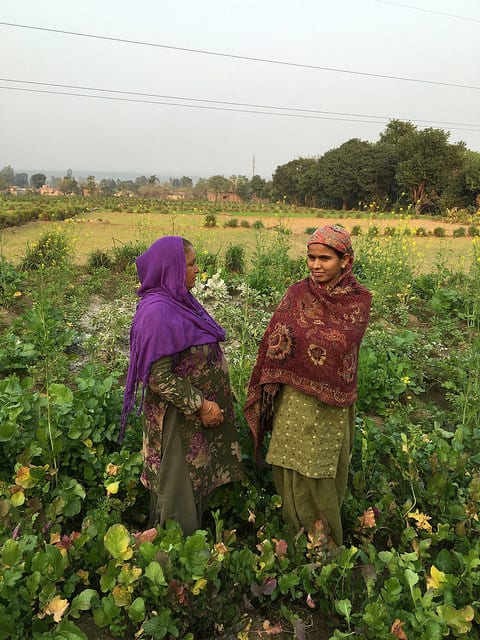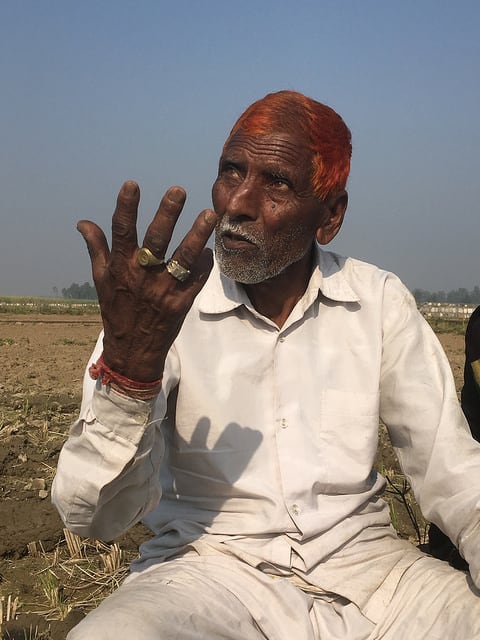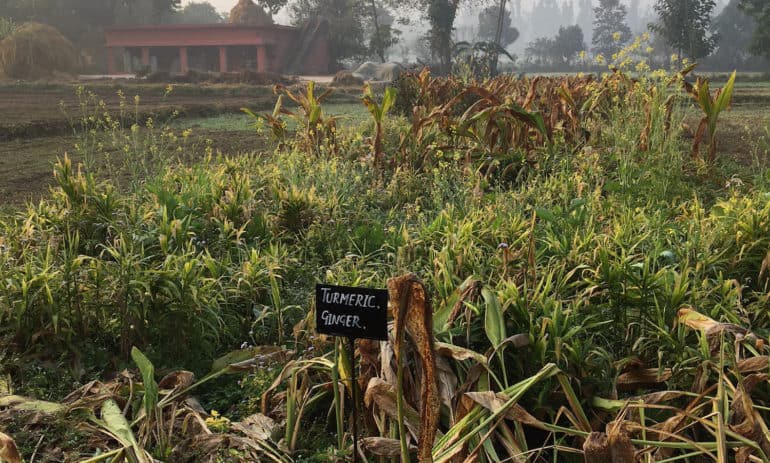Neha Raj seeks sleep on the night train from Delhi to Dehradun. It’s not the soundest slumber, but she’s grown accustomed to the sway of the rails. Neha teaches at Navdanya’s organic farm in the foothills of the Himalayas. Her teaching props are the hundreds of varieties of rice, wheat, millets, lentils, vegetables, oilseeds, and spices grown at the farm. Since the green revolution—when private seed companies entered Indian agriculture—India’s agrobiodiversity has shrunk dramatically. Neha teaches farmers how to preserve it.
Navandya encourages a mix of ancestral and modern farming techniques through the practice of agroecology. At the heart of their work is the observation that the green revolution has destroyed traditional knowledge that previously guided Indian farming communities. Now, most are poorer; their land and innards poisoned. Unable to pay off credit for expensive chemical pesticides and fertilizers, more than 300,000 Indian farmers have committed suicide, often drinking the very toxins they apply to their crops. Neha’s teaching is based on simple science and economics—farmers don’t need to bury themselves in debt to tend their crops. Healthy soils and climate-adapted, local seeds can generate adequate yields and well-fed children. Navdanya’s method isn’t anti-modern, but it is based on ancestral wisdom.

Neha took me to visit a farmer who had participated in Navdanya’s training program. I asked his advice for U.S. farmers, also deep in debt to agrochemical companies, planting row upon row of purchased, genetically modified corn seeds. “Cow dung,” he counseled. “Lots of cow dung.”
As we spoke, his wife poured pails of water on their cow—revered provider of milk and soil nutrients—and scrubbed vigorously. We walked past a composting pile of dung and straw that had yet to be plowed into his fields. Rather than buy seeds, he saves them from the previous year’s harvest. He’d planted a little bit of everything, spreading risk and diet among an astonishing variety of grains, tubers, and vegetables. There was always something to put on a plate.
Neha’s colleague, Drona Chetri, felt with his fingertips for a hidden key on top of a beam. The padlock to Navdanya’s central seed bank—smaller seed repositories are spread across the country—sprang open. Each week, Bija Devi and Sheila Devi, the Navdanya Seed Keepers, brandish smoking branches in the dirt-floored storehouse to dissuade insects and reduce moisture. To minimize contamination, he had me take off my shoes. In socks, I examined the labels of hundreds of glass jars, clay pots, and seed-laden stalks drying above on a twine line. Handwritten entries in a notebook described the conditions in which the seeds thrive and fail. In a live experiment, seeds are planted and returned each year—the circulation keeps them adapting to evolving ecosystems, essential in today’s quickly changing climatic conditions. It was a far cry from one-size-fits-all seeds cooked up in a Monsanto lab.
Each year, Drona travels back to his home in Bhutan to work with the Gross National Happiness Index (GNH). The index uses happiness indicators to prioritize policy directions and budget allocations. The higher a policy scores on the happiness index, the more support it gains. Coca-Cola doesn’t score well on the GNHI indicators for nutrition and so is not sold in Bhutan. Agrochemicals which expose soils and humans to uncertain toxicity, don’t score well either. The Bhutanese government is seeking Navdanya’s support to transition to a 100-percent organic farming.

As a teacher and advocate, Neha uses culture, science, and spirituality to illustrate agroecology. But she knows that the value must also express itself in rupees. When she can help them save money and reduce risks, they’re more likely to adopt new practices. If she’s lucky, that farmer will convince neighbors to do the same.
Neha brought me to a meeting of a women’s savings club. Each month, a dozen women roll out mats in front of a Hindu temple and make 100 rupee (approximately US$1.30) contributions. In delicate Hindi script, the secretary records transactions in a common ledger and within each contributors’ passbook. This meeting was particularly poignant because Prime Minister Modi had just demonetized India’s money supply. In an alleged surgical strike against black money, 500 and 1000 rupee notes were voided, to be turned in and replaced by new currency. Bank lines snaked for blocks; families couldn’t pay for their daughters’ weddings or buy seeds for planting. The savings and seed banks provided a small measure of economic and food security.
Navdanya’s farm is a small oasis amidst a massive water crisis. Thousands of wells in the area have sunk the water table. Where soil has been restored on Navdanya’s farm, groundwater had begun to percolate back up. Neha had me meet a farmer, vocal on matters of water and climate. His hair was hennaed bright orange; an oversize gold ring glinted on a gnarled finger. He tapped the rim of the irrigation ditch with his ringed finger.
“The problem is the cement,” he said. “Too much cement on roads, houses. In this irrigation ditch. Water can’t get into the soil and cool the earth.” Machetes high, the farmer’s neighbors whacked at the sugar cane in his field. In exchange for their labor, he offered them fodder for their cows, particularly useful in the long dry season.
Bartering labor for fodder doesn’t work for everyone, especially teens with their eyes on a pair of sneakers or a cell phone. Navdanya calls its approach, “Health Per Acre, Wealth Per Acre,” to project the idea that properly stewarded, an acre can provide sustenance and income. While purchased seeds may have a higher yield, they’re expensive. Neha explained that farmers tend not to subtract input costs from earnings. Neha teaches farmers to account for true costs and value forgotten assets like a chicken or a goat. Applying agroecological practices, farmers can earn up to US$2,500 an acre, a large sum in a country where the rural wage is often US$1 a day.

Mahatma Gandhi’s self-reliance is core to Navdanya’s teaching. So it was particularly galling to Neha when the government sought to outlaw cold-pressed mustard mills and introduce genetically engineered mustard plants. Mustard is native to Rajasthan and ubiquitous around Dehradun, the oil and greens are staples of the Indian peasant kitchen. The government alleged that rustic mustard oil mills were unhygienic and that patented mustard seeds would be more productive. Neha sees the attack on mustard as a stepping stone towards imported or industrially produced oils and away from support for peasant agriculture. Modi and Trump might strike a deal, she mused.
Over decades, Navdanya has led thousands of farmers into the streets and has made extensive use of the Indian courts. Navdanya works closely with land rights and tribal rights organizations, small farmer advocates which are powerful but often lack practical tools to build a sustainable food system. Neha works with partner organizations across India to train their members in agroecological and organic practices.
Towards dusk, Navdanya’s staff and interns—the latter having come to India tatted, pierced, and dreadlocked to get their hands dirty in Navdanya’s soil—played a spirited game of volleyball. The dusty court was hidden in a mango grove, not far from where winter wheat had begun to sprout. Navdanya’s training farm serves as an agroecological mecca for farmers from across the globe who seek to cultivate healthy food and a broad movement for change. Straddling urban and rural culture, still in her twenties and already a veteran of lengthy campaigns, Neha provides essential leadership for this growing movement.






